| Article ID | Journal | Published Year | Pages | File Type |
|---|---|---|---|---|
| 4993130 | International Journal of Heat and Fluid Flow | 2017 | 26 Pages |
Abstract
Two-degree-of-freedom vortex induced vibrations (VIVs) of two identical spring-supported circular cylinders in proximity with the mass ratio of 2 and zero damping at Re of 100 are numerically studied. Totally 20 arrangements of cylinders are investigated combining four stagger angles and five normalized center-to-center spacings. Results show that the in-line vibration amplitude is comparable to the transverse one for most arrangements and usually accompanies irregular cylinder trajectories. Extremely slender figure-8 cylinder trajectories usually seen in single-cylinder VIVs exist only for the tandem arrangements. Arranging the trailing cylinder to vibrate near the wake boundary of the leading cylinder enhances the possibility of irregular trajectories and impacts of both cylinders. Impact between cylinders must occur in cases with irregular cylinder trajectories; however, irregular cylinder trajectories could be found in impact-free cases. The stagger angle significantly changes the attribute of the transverse vibration frequency, toward either the single-cylinder VIV frequency or natural structure frequency in still fluid. The major transverse vibration frequency and the natural structure frequency in still fluid are decoupled for all the side-by-side arrangements and some far spaced tandem arrangements and highly correlated for non-tandem and non-side-by-side arrangements. The time-averaged impact frequency increases with decreasing normalized center-to-center spacing for most combinations of stagger angle and reduced velocity. Apart from the side-by-side arrangements, high-frequency impacts occur when the trailing cylinder is initially located in or near the wake zone of the leading cylinder. The mechanism of trailing cylinder chopping the gap-flow vortices plays an important role in determining the near-wake vortex structures for all non-side-by-side arrangements.
Related Topics
Physical Sciences and Engineering
Chemical Engineering
Fluid Flow and Transfer Processes
Authors
Meng-Hsuan Chung,
